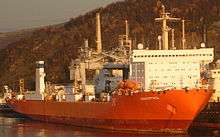- Sevmorput
-
Sevmorput (Севморпуть) is a Russian nuclear-powered cargo ship with ice breaking abilities, one of only four nuclear-powered cargo ships ever built. It is the only one of these four ships still operating under nuclear power, with the others having been retired or been converted to diesel propulsion. The Sevmorput, as a type of cargo ship, is classified as a Lighter Aboard Ship, transporting lighters and ISO standard containers in specially provided cells in the bilge and on the main deck. It was constructed in Kerch, Ukraine at the Zaliv shipbuilding plant. The ship was completed in 1988.
The name of the vessel, Sevmorput, is a Russian abbreviation of Severny Morskoy Put (Северный Морской Путь), i.e. the Northern Sea Route.
Earlier owned and operated by the Murmansk Shipping Company, Sevmorput was transferred to Rosatom in August 2008.[1]
The supposed conversion of the Sevmorput into an oil drilling vessel, as of August 2007, expected to take only 18 months.[2] Currently the project is underway and trials have already been run with Lukoil contributing the lions share of conversion and modernization of the Sevmorput with the rest funded by the government. In spite of contention over a timetable for an trans-arctic voyage the expectations are high amongst those involved in the program.[3]
Contents
Specifications (prior conversion)
- Length : 854 ft (260.3 meters)
- Beam : 105.6 ft (32.2 meters)[4]
- Hull side height : 60 ft (18.3 meters)
- Draught to summer load mark : 38.7 ft (11.8 meters)[4]
- Specific draught (for running in ice) : 35 ft (10.65 meters)[4]
- Water ballast : 22,895 metric tons (25,237.5 short tons)
- Cargo : up to 74 lighters[4] (depending on their weight), weighing up to 450 tons each, or up to 1336 containers (depending on their size), weighing up to 20.3 tons for the 20 ft and 30.5 tons for the 40 ft ISO standard containers
- Deadweight at draught up to summer load mark : 33,980 metric tons (37,456.5 short tons)
- Deadweight at draught for running in ice : 26,420 metric tons (29,123 short tons)
- Displacement in seawater of density 1.025 t/m3 at draught up to summer load mark (11.8 m) : 61,880 metric tons (68,211 short tons)
- Speed : 20.8 knots (24 mph | 38.5 km/h) at 32.8 ft (10 m) draught
- Propulsion : 29,420 kW[4] (39,437 electrical horsepower)
- Power Plant : two KLT-40 reactor[citation needed]
- Auxiliary units :
- 3 turbogenerators, 2000 kW each
- 2 spare diesel generators, 600 kW each
- 2 emergency diesel generators, 200 kW each
- An emergency run boiler with 50 t/h steam output at 25 kg/cm2 pressure and 360°C steam temperature working on diesel fuel
- Sevmorput is capable of breaking ice up to 1.2 meters thick[4]
See also
References
- ^ Rosatom takes over Russia’s nuclear powered icebreaker fleet, Bellona, 28/08-2008
- ^ Murmansk gets the world’s first nuclear-powered oil drilling vessel, article of 2007-08-07 on barentsobserver.com
- ^ [1]
- ^ a b c d e f Joint Stock Company "Shipyard Zaliv". "Engine output 29420 kW ... Moving through ice on its own 1,2 m"
External links
- Лихтеровоз-контейнеровоз "СЕВМОРПУТЬ". 1988 г. - (in Russian) specifications, short history, images
- Sevmorput - nuclear container ship - Images and general information
- The "SEVMORPUT" nuclear powered lighter-aboard ship - archived Murmansk Shipping Company page
Categories:- Ships built in the Soviet Union
- Nuclear-powered merchant ships
- Merchant ships of the Soviet Union
Wikimedia Foundation. 2010.

